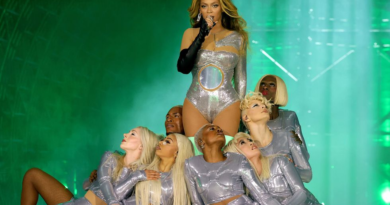Fashion Enters a New Age of Enlightenment
Style Points is a weekly column about how fashion intersects with the wider world.
Of all the things to re-enter the fashion chat for spring, an 18th-century accoutrement that has zero real-world practicality was probably not on anyone’s bingo card. Nevertheless, panniers, or hooped petticoats undergirding the hips, and their 16th- and 17th-century relatives, farthingales, stepped out of the history books and onto the spring runways. Their reach included both big names (Dior, Loewe) and rising talents (Elena Velez, Matty Bovan, Del Core).
The pannier might as well be a vestigial organ of fashion at this point: You probably associate the motif most with pre-revolution Marie Antoinette. That said, designers like Jean Paul Gaultier and Sarah Burton have shown riffs on the theme over the last few decades. Which is why Valerie Steele, the director and chief curator of the Museum at the Fashion Institute of Technology, doesn’t perceive the trend as a direct return to the period, but as a reference to more modern designers who were themselves referencing these motifs, like Christian Lacroix, Alexander McQueen, and Vivienne Westwood. Think of it as a game of fashion Telephone.
Dr. Kimberly Chrisman-Campbell, a fashion historian and author of books including Skirts: Fashioning Modern Femininity in the 20th Century, agrees. “I do think all these collections were filtered through the lens of 1980s historicism—the New Romantics, Westwood’s mini-crini, and Lacroix’s pouf,” she says. “Both the ’80s and the 18th century were ages of excess and maximalism in dress, so it makes sense that they are back as we emerge from the pandemic excited about fashion and dressing up again.”
[image id=’dcd276ed-24ae-44b9-b113-78af04fb00c0′ mediaId=’31561d12-77f1-4cdc-90f7-a95364b793d0′ align=’center’ size=’medium’ share=’false’ caption=’Loewe spring 2023.’ expand=” crop=’original’]
As antique as these shapes may feel, they have one advantage in a digital age when most of us will see designers’ creations on a screen: immediate, almost 3D-level impact. In Jonathan Anderson’s take on the style at Loewe, Steele sees allusions to “a variety of foundation garments, from 16th-century farthingale through 1950s petticoats.” (In a recent interview, Anderson told me that another reference point was an aerial view of a menswear-style jacket.) But though it’s steeped in historicism, the shape does something very contemporary, says Steele: “The thing has to jump out of that screen at you, and certainly an unusual silhouette will do that.”
For the women who wore them back then, being able to maneuver with the added cargo became an art form—and double-wide gowns turned into a marker of social status. Rather than draping themselves in logos, socialites of the era could flex their fashion cred purely through volume. “Because the fabric was far and away the most expensive part of a dress, you wanted to show that off,” explains Steele. “You’re showing off all the money involved in the dress, which is not the designer name, but the fabric. That’s the expensive part; the workmanship costs nothing. Also, it makes the waist look tiny in comparison with the hips, so it’s [creating] what anthropologists call an exaggerated waist-hip differential, which is what young, nubile, fertile women have.”
Says Chrisman-Campbell, “A bigger skirt meant more fabric, and thus more money and power. A stiff understructure like a pannier or farthingale supported and showed off all that fabric more effectively and more comfortably than layers of petticoats.”
As cumbersome as these styles were to wear, they were also counterintuitively liberating, or at least somewhat threatening to the social order. Male critics attacked them for being unnatural in their sculpting of the body, using language that’s eerily similar to later critiques of corsets, padded bras, Spanx, and even plastic surgery. The style was also thought to encourage promiscuity, since it obscured whether or not the wearer was pregnant. “People assume that women in the past were [completely] victims of patriarchy,” Steele says. “But although patriarchal society was very powerful, and women had very few legal or socioeconomic rights, let alone political ones, nevertheless, in the presentation of their body, women had considerable say. And one of the ways that they said, ‘I am an important person, take account of me,’ was through their self-presentation.”
While it’s unlikely we’ll see panniers making a comeback off-runway—door frames would have to get a lot wider, for one thing—this idea of women taking up space remains a provocative one four centuries later. Steele references the British psychologist John Carl Flügel, who wrote about the connection between big clothing and making a big impression. “Just the size of this dress,” she notes, “is saying ‘pay attention.’”
That kind of sartorial real estate has the same effect even now. “In the past, extravagant clothing was a way that women who had money but no real voice in society could make themselves seen and heard,” Chrisman-Campbell says. “Today, fashion is comparatively affordable, and many more women are financially independent, with the means to participate in fashion. But, at the same time, they are being silenced or overlooked in other areas. It’s hard to ignore someone who is taking up physical space, and fashion is an effective way of doing that—we just saw a great example of this with Tems at the Oscars,” in her elaborate, view-obscuring veil. Just as trendlets like bimbocore and “Free the Nipple 2.0” feel like response ripples to the Dobbs ruling, so does the weaponizing of space via voluminous fashion.
This content is imported from Twitter. You may be able to find the same content in another format, or you may be able to find more information, at their web site.
Which might explain why so many designers seemed to have a pre-guillotine Marie Antoinette on their mood boards. Not to mention that in a time of inflation, ballooning economic inequality, and bank runs, her heyday may also feel uncomfortably familiar. As Steele says of the pre-crash 1980s styles by the likes of Lacroix: “They were very much dancing on the edge of the precipice. It’s like before the revolution.”
To Steele, though, the trend reads less as social commentary and more as a seasonal pendulum swing. “If last season you were emphasizing the naked body, and if this season you’re emphasizing the body that’s taking up space, well, in both cases, you’re emphasizing bodies,” she concludes, “which is pretty much what fashion is about.”









